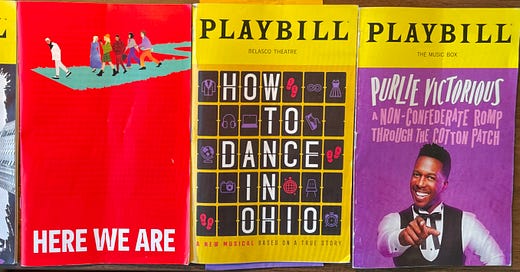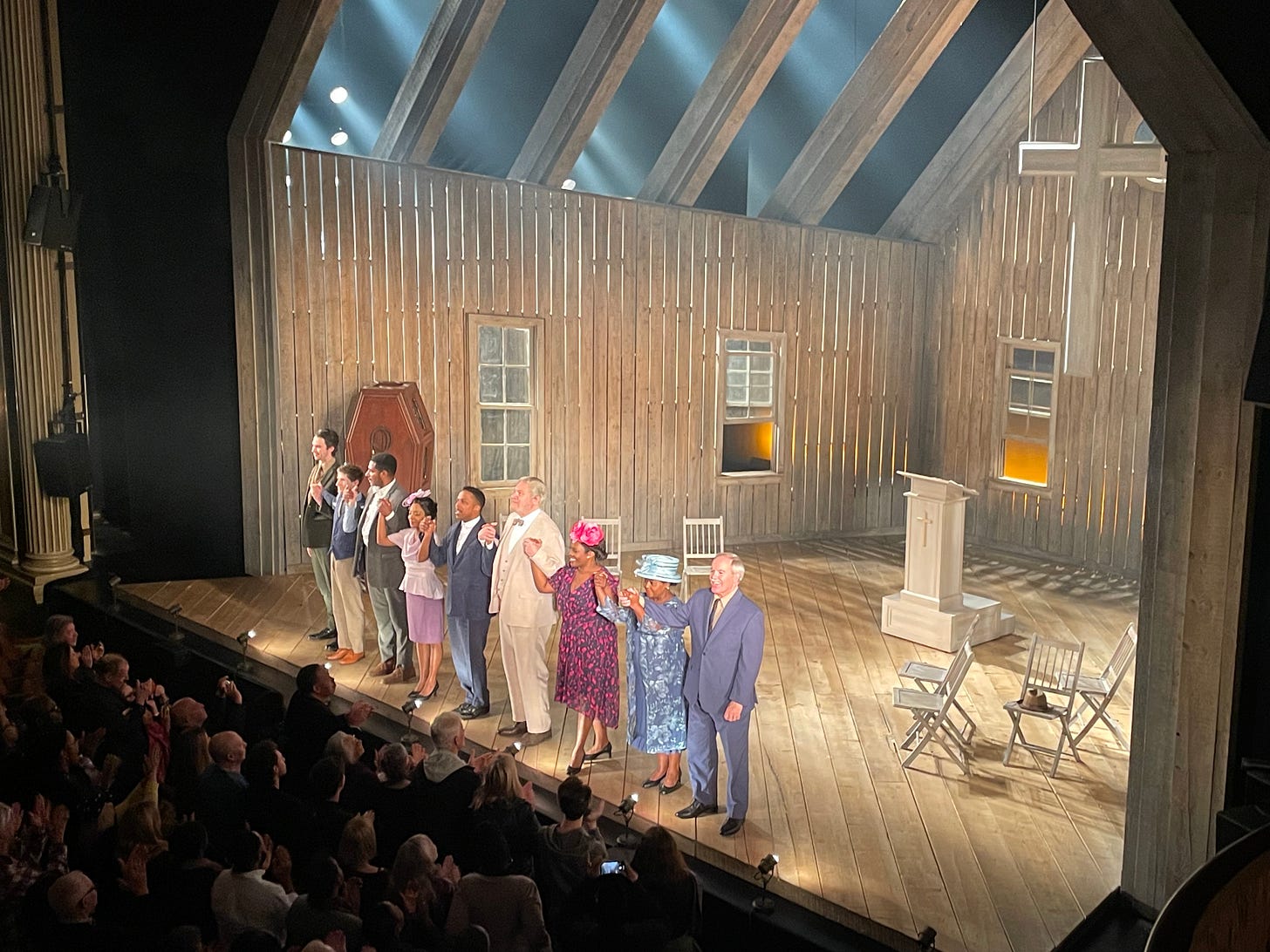A moving story in "How to Dance in Ohio", plus a hilarious racial satire, "Purlie Victorious"
My reviews of two Broadway productions playing now in New York
Here’s part two of my reviews following my most recent NYC trip. Let me know if you’ve seen these and what you thought!
How to Dance in Ohio
The brand new “How to Dance in Ohio” does what excellent musical theater can do so well: inspire connection to a lived experience different from our own. Through the specificity of a story about autistic young adults learning social skills as they prepare for a formal dance, we grasp at the universal experience of struggling toward a goal, experiencing a milestone, and taking agency over your life. I found the piece very moving and surprised myself at how deeply I connected with it. I am not autistic, but I remember how important dances felt when I was growing up—they truly are a rite of passage. A lonely kid, I would show up alone to school dances—nervous but excited to give it a try. So I wept as I watched these compelling characters go through a different journey towards the same end.
What’s remarkable in this sweet, full-of-heart story is that each of the seven principal characters, plus their counselor and his daughter, are all well-rounded, with intersecting plots and compelling character developments. Even their parents, necessarily flatter characters, are given great songs, in particular “Getting Ready for the Dance,” sung by the mothers of two women in the group reminiscing about their own formal dances, and wishing the same for their daughters. It brought me to tears!
The first act proceeds in many ways as you might imagine it to: the young adults have a lot of angst about the dance and go through several “lessons” as they prepare. The conflict here is mostly interior: each character is working through their own personal growth as they try to do something difficult for autistic people to do. This is certainly moving, but in the second act, a more external, shared conflict emerges, as the leader of the counseling group meets with journalists to tell their story, but ends up telling his story. What started as a largely paternalistic tale about helping disabled people do something difficult becomes inverted as they develop their own agency.
I appreciated the way the story handled intersectionality. Each of the character’s racial, class, and gender/sexuality identities show up in specific ways. This helped advance another theme of the show: that not all autistic people are the same.
Adding to the complexity was a meta-theatrical issue: much of the news about the show has focused on the history-making casting of autistic actors to play all seven autistic characters—the first time autistic characters have been played by autistic actors on Broadway. At the top of the show, the actors introduce themselves and tell the audience “now you know seven autistic people,” foregrounding this casting choice. Are we inspired that these “disabled” people are acting on Broadway? If so, we’re dissuaded from that in Act 2, when the characters sing about their frustration with always seeming to exist only to inspire non-autistic people. Is the show calling us in, trying to help us learn right there in the moment? In the end, the casting choice is important for representation, authenticity, and inclusion; but not as a tool to inspire others. Rather, it was essential in order to tell this particular story.
The production marks the Broadway debuts of the young, hot director Sammi Cannold (who directed the recent DC production of “Evita”) and the songwriting team Rebecca Greer Metlock and Jacob Yandura. The score is beautiful, and served the story well.
The program noted that the show’s design is intended to be “sensory friendly”. I enjoyed the relative simplicity of the set: a series of sliding metal panels that came in and out to convey different settings. The other main design choice was a series of letters. I interpreted this as representative of the jumble of confusing social cues that many autistic people experience. Only occasionally did the letters arrange into actual words, reading “How to Dance in Ohio.”
I think this one is a contender for the coveted Best Musical Tony. I absolutely loved it.
Playing an open run at the Belasco Theatre (a particularly beautiful Broadway house)
Purlie Victorious: A Non-Confederate Romp Through the Cotton Patch
They don’t make ‘em like they used to! That was my first thought as the house lights came up following the wickedly clever “Purlie Victorious.” The best part of this play is the sheer strength of Ossie Davis’s writing—brilliant racial commentary embedded in a tightly-constructed comedy; multi-layered jokes perfectly balanced with dramatic moments; and a clever, satisfying resolution.
The play concerns Purlie, a self-proclaimed preacher who returns to his hometown with a new woman friend to pose as one of his deceased relations and claim the inheritance owed her in order to build a church. The person holding the money? A white, Confederate-aligned land-owner who employs many of the Black people in town.
Along the way, the biting racial satire goes down easy, packaged as it is with so much comedy sugar. The white land-owner, portrayed as an embodiment of racism writ large, is portrayed as equal parts foolish and menacing—helping to show the ridiculousness of racism. While the story had repeated references to the Supreme Court’s Brown vs. Board of Education decision (it originally premiered in 1961), it still felt timeless given the disappointing reality that racism remains prevalent today.
One moment really stuck out to me: Purlie presents the white land-owner with a fake “certificate” from all of the Black workers he employs proclaiming him the White Father of the Year, meant to warm up his sympathies so he’ll give over the inheritance. The white man is profoundly moved by the approbation, as it confirms his paternalistic view of African-Americans: that they indeed prefer the power relations which put him on top. This moment was played for laughs, but I thought it also illuminated something about the feelings of many of my contemporary white liberals. The approval of Black people is validating for us for a different reason: it assuages our deepest insecurity that we are racist. This is an example of how capacious and timeless the writing is.
The performances were pitch-perfect. Leslie Odom Jr. nailed the preacher’s fast-talking, grandiose energy. I couldn’t believe how many words came out of his mouth in a minute. The overall effect was of an impassioned if sometimes goofy figure, dead set on creating his church. As the friend of Purlie and impersonator of the inheritor, Kara Young gave the character a simpleness that was perfect for the comedy. One choice in particular worked well: she frequently walked or stood with her feet arranged pointed in toward each other, using this physicality to bring out the character’s awkwardness.
The in-demand Kenny Leon’s direction ratcheted up the comedy, as he sent his characters running around Derek McLane’s lovely, wood-paneled set, with a concluding gesture (which I won't spoil) that perfectly represented the lightening of the load on Black people that Purlie so desires. Elegant lighting design from Adam Honoré conveyed time of day and mood with soft light filtering in through the gaps in the wood walls.
Playing through February 4 at the Music Box
***
These are just some of the great things playing in New York right now! Check out this post for an overview. Thank you so much for reading and I’ll be back soon with more!






